Sous Vide Salmon with Wet and Dry Brine
Sous vide salmon is by far the best way to make buttery, moist, and flaky salmon with a gorgeous pink color. Wet and dry brine recipes included.
When I started sous vide cooking in 2018, salmon was one of the very first things that I dropped into the water bath. Nervous, anxious, excited, hopeful, you name it, I had a mix of feelings while pacing in my small apartment in Hong Kong.
It took 40 minutes.
And I was completely sold on this sous vide thing, right there.
Fast forward to today, sous vide has long since become my primary cooking method living in Hong Kong. By now, I have a record number of sous vide salmon experiences that I would like to share with you.
In this post, you’ll learn everything about how to sous vide salmon to perfection every single time including both wet brine and dry brine methods. Let’s dive in.
- Why Sous Vide Salmon?
- How Does Cooking Salmon Sous Vide Compare to Other Cooking Methods?
- How Long Does It Take to Sous Vide Salmon?
- At What Temperature Do You Sous Vide Salmon?
- Can You Sous Vide Frozen Salmon?
- Sous Vide Salmon Cook Time and Temperature Chart
- Brine or No Brine?
- Sear or No Sear?
- Essential Equipment
- How to Sous Vide Salmon Step by Step
- StreetSmart Tips for Sous Vide Salmon
- What to Serve with Sous Vide Salmon?
- Sous Vide Salmon Recipe
- About the Author
Why Sous Vide Salmon?
Salmon is a delicate fish, and it is not cheap. When cooked properly, a balanced salmon meal is not only visually appealing but satisfying to the tastebuds, and it nourishes your body with its good source of protein, omega-3 fatty acids, and numerous other health benefits.
When it comes to an expensive piece of protein, the last thing you want to do is to overcook it. Am I right? So first and foremost, you’ll never have to worry about overcooking salmon ever again using the sous vide method. From there, the benefits of sous vide salmon pile up.
- It removes the guesswork from the cooking process entirely, so you can sit back and relax, knowing that your salmon will come out of the water perfectly each time.
- Selecting the right temperature gives you full control over the salmon texture you desire or never knew was possible.
- You can easily change flavors by using different marinades and adding aromatics and fat.
How Does Cooking Salmon Sous Vide Compare to Other Cooking Methods?
To expand on why sous vide salmon works so well, let’s look at how it compares to other cooking methods.
- Pan-seared: To achieve a perfectly cooked piece of salmon in a hot pan on the stovetop isn’t easy peasy. It takes practice to get a hang of the optimal heat level and the cooking time for salmon. Normally, pan-seared salmon is cooked more on the outside than on the inside. It’s nearly impossible to achieve the same texture from the edge to the center with this cooking method. Overcooking salmon this way isn’t a new story.
- Poached: With practice, getting that medium-rare center with poaching is doable but again, not easy. Depending on what you poach your salmon in, the heat, and the poaching time, the outcome likely varies—it’s not guaranteed.
- Baked: A go-to temperature and time for baked salmon are 375°F (190°C) for 15 minutes. If you want to make the surface a little brown, you may broil it for an additional 5 minutes in the oven. You can’t really go wrong with this cooking method, but you’ll need to be there to take your salmon out of the oven as soon as the timer goes off. There’s no wiggle room here.
- Grilled: I have very little experience with grilling salmon. I am intimidated to put a piece of delicate fish on the open fire…
Comparatively, sous vide salmon not only guarantees the perfect result every single time, but it’s also foolproof, with no guesswork or babysitting required, lots of wiggle room in terms of the cooking time, and you can be fearless because you won’t overcook your salmon, ever!
There’s one more difference that I have to mention—the color! Sous vide salmon gives you this translucent pink that no other cooking method can do. It’s absolutely gorgeous!
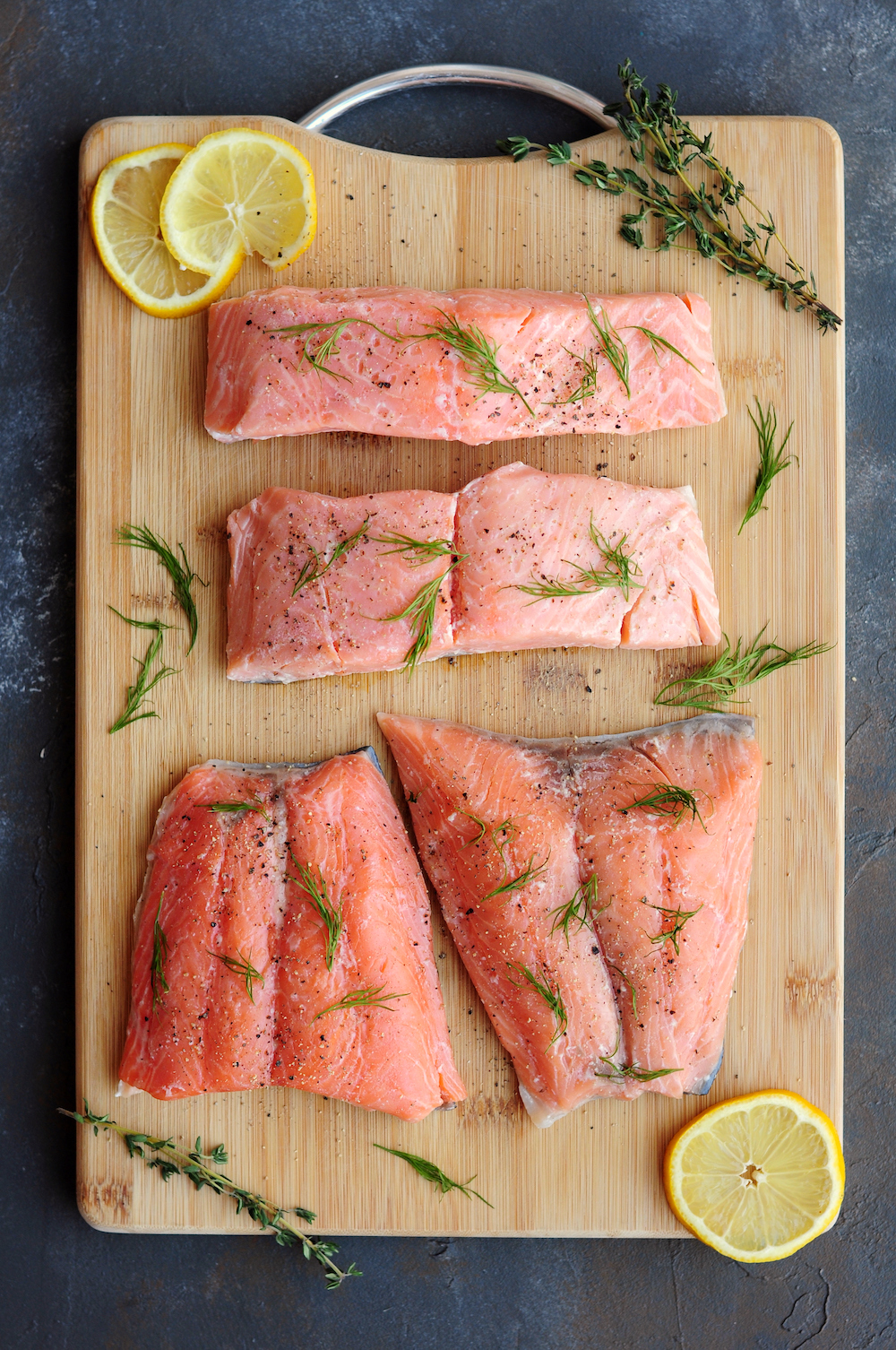
How Long Does It Take to Sous Vide Salmon?
It doesn’t take very long for salmon to be perfectly cooked in the sous vide.
For thinner filets (or fillets) between 1 and 1.5 inches, 30 to 40 minutes of cooking time is sufficient.
For thicker pieces between 1.5 and 2 inches, 45 minutes to 1 hour is all you need.
My go-to cook time for sous vide salmon is 40 minutes. I usually set the timer for 40 minutes, and if it stays in the water bath for a tad longer for whatever reason, it’s fine.
At What Temperature Do You Sous Vide Salmon?
For many other types of protein, one or two degrees in cooking temperature doesn’t really make a noticeable difference in the texture and doneness. That’s not the case for salmon due to the softly setting protein!
The temperature range for sous vide salmon is between 105°F (41°C) and 130°F (54°C). Here is the vast difference in texture achieved with a slight adjustment of the temperature.
- 105°F (41°C): Sashimi-like but firm
- 110°F (43ºC): Very soft and creamy
- 115°F (46°C): Moist, buttery, and starting to get flaky
- 122°F (50°C): Moist, tender, translucent pink, and flaky
- 130°F (54°C): Moist, firm, and flaky
My favorite temperature to sous vide salmon is 122°F (50°C). The texture of the finished fish is just incredible.
Please note that salmon cooked above the pasteurization point at 131°F (55°C) is not as perfect as when it’s cooked at one of the above temperatures. But it’s still good! For safety reasons, if you are cooking for kids, pregnant women, or someone with a weak immune system, cook it at 131°F (55°C). That’s what I do for my 4-year-old son.
Can You Sous Vide Frozen Salmon?
Absolutely! Sous vide frozen salmon works beautifully. Here’s how you do it.
- Preheat a water bath to your desired temperature using a sous vide cooker.
- Rinse the salmon filets under cold water to remove ice crystals on the surface.
- Pat them dry with a clean kitchen cloth. If you use paper towels, the paper will stick on the frozen filets.
- Bag the salmon, and add a little olive oil or other aromatics and herbs of your choice. (You can choose to season it before or after sous vide cooking.)
- Submerge the salmon under the water and set the timer for 1.5 times longer than cooking fresh salmon sous vide. For example, if you normally cook fresh salmon filets for 30 minutes, cook frozen ones for 45 minutes.
Sous Vide Salmon Cook Time and Temperature Chart
| Cook Temperature | Texture | Cook Time (Fresh) | Cook Time (Frozen) |
| 105°F (41°C) | Sashimi-like but firm | 40 minutes | 1 hour |
| 110°F (43ºC) | Very soft and creamy | 40 minutes | 1 hour |
| 115°F (46°C) | Moist, buttery, and starting to get flaky | 40 minutes | 1 hour |
| 122°F (50°C) | Moist, tender, translucent pink, and flaky | 40 minutes | 1 hour |
| 130°F (54°C) | Moist, firm, and flaky | 40 minutes | 1 hour |
Brine or No Brine?
Brine or no brine is a personal question. It’s entirely up to your preferences. I’m going to share my experiences with a wet brine and a dry brine for salmon before sous vide cooking, so you can try and decide which one will work for you. Or maybe no brine at all, which is perfectly fine too.
Wet Brine
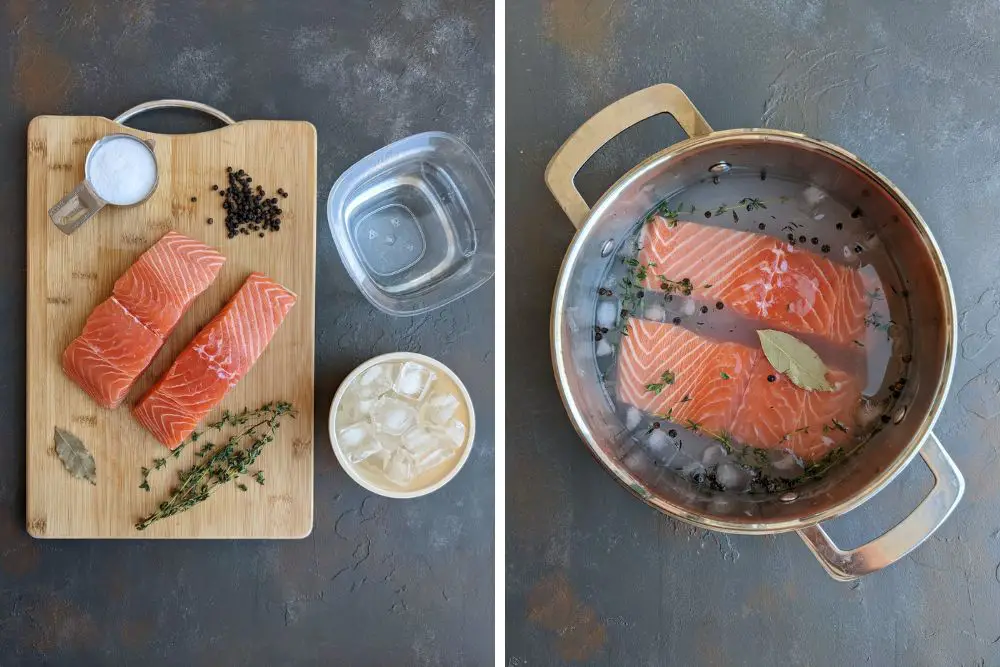
Why wet brine? It produces more flavor and a firmer texture, but there’s a more scientific underlying reason that you might want to consider.
You probably noticed that there is often some white stuff on the surface when your salmon is cooked. That white stuff is called white albumin, a protein that coagulates and becomes semi-solid when heated. There’s nothing bad about this protein. It’s just that many people find it visually unappealing, especially when you are making a nice dinner. So if you care for the look of it as well, the wet brining process is supposed to help minimize the white albumin.
A wet brine typically requires salt and water (1 tablespoon of salt for 1 cup of water). Use warm water to start with, so the salt can dissolve completely, then add ice water to cool the brine down. For salmon, I’d recommend adding black peppercorn, fresh thyme, bay leaves, or even coriander seeds for more flavor.
You will need at least 30 minutes and up to 60 minutes for the brining process to complete before cooking.
Dry Brine
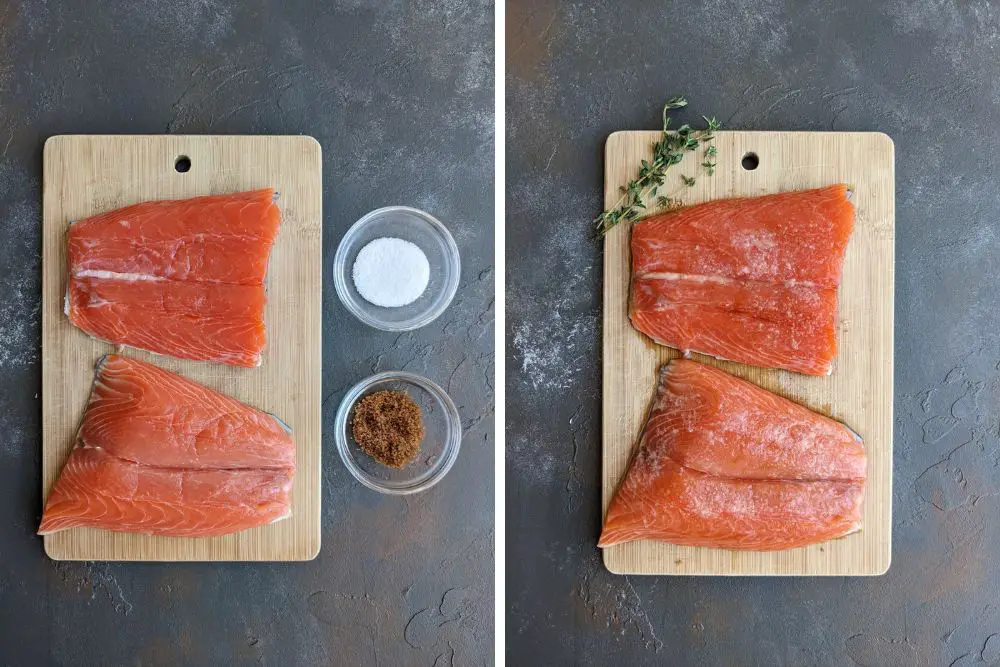
Why dry brine? Dry brine doesn’t work as well as wet brine in terms of getting rid of the white albumin in salmon. It does, however, provide a more intense flavor and it helps retain a firm but moist texture.
A dry brine typically calls for salt and sugar. The ratio is 4:1. I normally use brown sugar for my brine. All you need to do is to sprinkle salt and sugar evenly over your salmon and let it sit for 10 minutes. Rinse it off and cook away!
Wet Brine vs Dry Brine
Wet brine helps minimize white albumin and enhances the flavor of your salmon. You’ll need a container that’s large enough to hold the salmon and the brine—salt and water and some other ingredients. You’ll also need 30-60 minutes of brining time before cooking.
Dry brine gives your salmon a hint of saltiness and sweetness. It requires only salt and sugar. You need just 10 minutes of brining time.
Brining, either wet or dry, results in a smooth, buttery texture of sous vide salmon at a low temperature, and it retains more moisture at a higher temperature.
Is one better than another? Not necessarily. If you have more time, go for the wet brine and see what difference it makes to your salmon. If you are short on time, dry brine is a very nice and efficient way to deeply season your salmon and hold it together for an amazing texture. I often dry-brine my salmon.
Also, you don’t have to brine your salmon before cooking. Just note that your fish might come out slightly mushy and watery without brine when cooking at a low temperature. The bottom line is to do what works best for you and your schedule.
Sear or No Sear?
Many suggest finishing sous vide salmon with a quick sear on the skin side in an oiled cast-iron pan over high heat. Crispy salmon skin can be very delicious, but you’ll have to be very very delicate, careful, and gentle when searing sous vide salmon, as it’s so soft and tender that it can fall apart easily.
You certainly can, as I often do, serve your sous vide salmon straight out of the bag without searing. A few grinds of fresh black pepper and some fresh herbs to garnish is more than enough. Sous vide salmon has an incredible texture and color. It’s extremely tender and moist. Trust me–you’ll be very satisfied even without searing.
Essential Equipment
- A sous vide immersion circulator. I used an Anova Precision Cooker for my sous vide salmon.
- A large pot or a sous vide container. I personally use an Anova sous vide cooking container which holds up to 16L of water with a removable lid and a rack to prevent food from floating. But if you have a large pot, it works just fine.
- Ziploc bags or vacuum sealer bags. You do not need a vacuum sealer and vacuum seal bags for sous vide salmon. Use Ziploc bags and add oil to prevent the fish from sticking together if you put more than two filets in one bag, then submerge the bags using the water displacement method. I found using a vacuum sealer with vacuum sealer bags or reusable sous vide bags for cooking sous vide produces better results. So I would highly recommend investing in a vacuum sealer if you foresee sous vide becoming a regular cooking method for you.
How to Sous Vide Salmon Step by Step
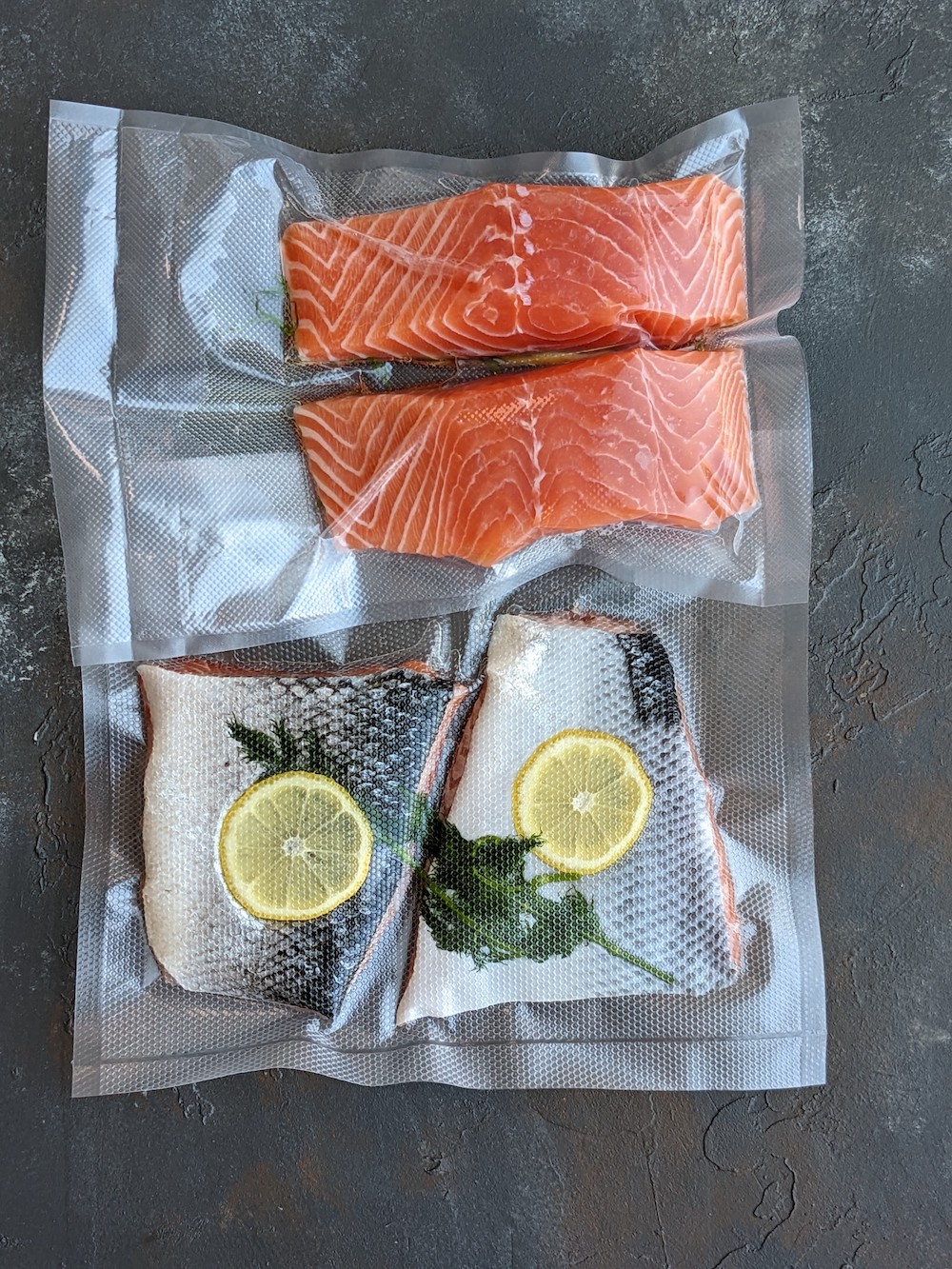
- Choose your brine. For the wet brine: Place warm water in a large container with decent depth. Stir in salt until it dissolves. Add black peppercorns, fresh thyme, and coriander seeds if using, followed by ice to cool the brine down. Gently place your salmon filets into the brine, ensuring they are completely submerged. Let it sit for 30 to 60 minutes. For the dry brine: Rub salmon filets with salt and brown sugar, using roughly one part of brown sugar for every four parts of salt. Brine for 10 minutes and rinse off the salt and sugar under cold water.
- Sous vide the salmon: Preheat water to 122°F (50°C). After the salmon filets are brined, gently pat them dry with paper towels and slide them into prepared vacuum sealer bags or Ziploc bags in one single layer with some space in between each filet. Add lemon slices, dill sprigs to the skin side of the fish, and oil. Vacuum seal or use the water displacement method. Submerge the bags under the sous vide bath and set the timer for 40 minutes.
- To finish/serve the salmon: Very carefully transfer the salmon filets to a serving plate. Discard the dill and lemon. Sprinkle with freshly ground black pepper and fresh dill. Serve immediately. (You can also sear the skin side in a hot pan for about a minute or until crisp.)
StreetSmart Tips for Sous Vide Salmon
- Pick fresh salmon. It doesn’t matter if you choose king salmon, Atlantic salmon, or sockeye, the best salmon is the freshest salmon that fits your budget! Fresh fish should have firm flesh and hold its shape after being touched.
- Keep the skin on for two reasons. 1) Add aromatics or herbs on the salmon skin side to retain the smoothness of the delicate fish meat without any marks being pressed onto it after cooking. 2) Crispy salmon skin is delicious if you give it a sear after sous vide cooking.
- Brine your salmon. Whether you choose to wet brine or dry brine your salmon prior to cooking, it will provide a way better texture compared to no brine.
- Add fat. If you are cooking more than one piece of salmon in one plastic bag, adding fat is essential. Salmon proteins will bind together under heat when in contact. Fat helps coat the fish and keeps the filets from turning into one piece after cooking.
- Leave space between filets. For the same reason—to keep salmon pieces separate in one cooking bag, leave some space between the filets and vacuum seal. It locks the filets in their position, so you don’t have to worry about them moving towards one another when they’re under the water for a while.
- Rapid chill before refrigeration. If you don’t plan on serving your sous vide salmon right away, transfer the cooking bag from the sous vide bath directly into an ice-water bath to chill it rapidly, then refrigerate it. Salmon can be stored in the fridge for up to three days. If vacuum sealed, it will keep its freshness for up to six days.
What to Serve with Sous Vide Salmon?
For a full balanced meal, serve your salmon with dirty rice (Vegetarian Cajun Rice) and green beans. If you choose to wet-brine your salmon, you can blanch green beans in the brine. The green beans will be perfectly flavored and there’s no waste of the brine.
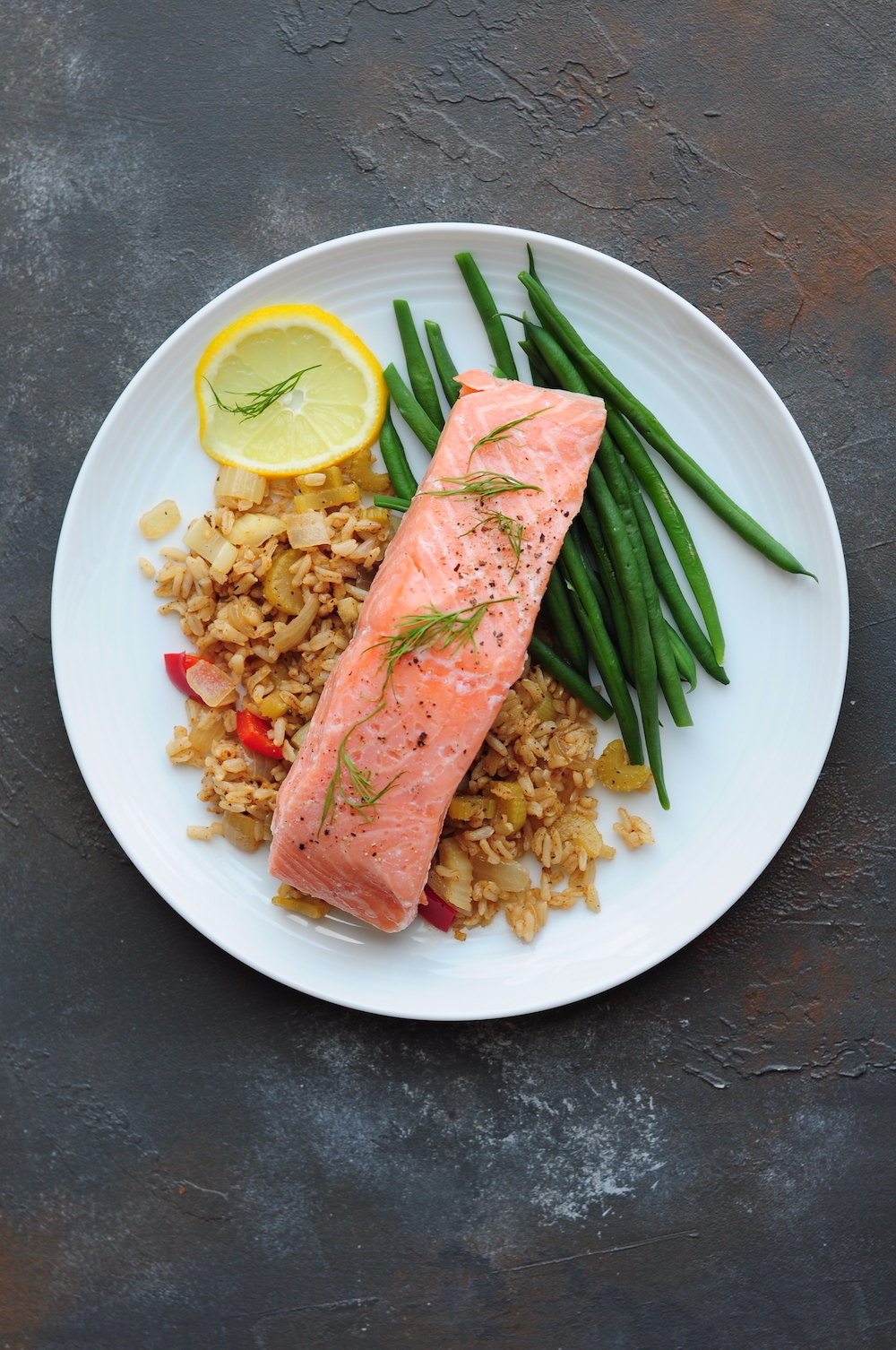
For a low-carb meal, consider serving your salmon with the following side dishes:
- Zesty Garlic Lemon Green Beans
- Massaged Kale Salad with Pine Nuts and Dried Cranberries
- Spiced Honey Butter Carrots
- Roasted Brussels Sprouts with Crispy Garlic and Almond
- Pan-Steamed Broccolini and Portobello Mushrooms
- Sautéed Bok Choy with Shiitake Mushrooms
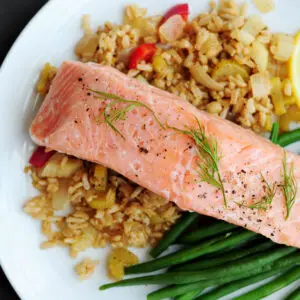
Sous Vide Salmon Recipe
- Prep Time: 15 minutes including dry brine time
- Cook Time: 40 minutes
- Total Time: 55 minutes
- Yield: 4
- Category: Seafood
- Method: Sous Vide
- Cuisine: American
- Diet: Gluten Free
Description
Sous vide salmon is by far the best way to make buttery, moist, and flaky salmon with a gorgeous pink color. Wet and dry brine recipes included.
Ingredients
- 4 (5 to 6-ounce) salmon fillets, skin on
- 1 lemon, sliced
- Fresh dill sprigs
- Extra-virgin olive oil
- Freshly ground black pepper to serve
For the wet brine:
- 2 cups warm water
- 4 tablespoons sea salt
- A pinch of black peppercorns
- A few sprigs of fresh thyme
- 1 teaspoon coriander seeds (optional)
- 2 cups ice
For the dry brine:
- 4 parts of sea salt
- 1 part of brown sugar
Instructions
- To wet brine salmon: Place warm water in a large container with decent depth. Stir in salt until it dissolves. Add black peppercorns, fresh thyme, and coriander seeds if using, followed by ice to cool the brine down. Gently place your salmon filets into the brine, ensuring they are completely submerged. Let it sit for 30 to 60 minutes.
- To dry brine salmon: Rub salmon filets with salt and brown sugar using roughly one part of brown sugar for every four parts of salt. Brine for 10 minutes and rinse off the salt and sugar.
- Sous vide the salmon: Preheat water to 122°F (50°C) using a sous vide machine. After the salmon filets are brined, gently pat them dry with paper towels and slide them into prepared vacuum sealer bags or ziplock bags in one single layer with some space in between each filet. Add lemon slices and dill sprigs to the skin side of the fish, then add some olive oil. Vacuum seal or use the water displacement method. Submerge the bags under the sous vide bath and set the timer for 40 minutes.
- To finish/serve the salmon: Very carefully transfer the salmon filets to a serving plate. Discard the dill and lemon. Sprinkle with freshly ground black pepper and fresh dill. Serve immediately. (You can also sear the skin side in a hot pan for about a minute or until crisp.)
Notes
Nutrition facts are estimated without the ingredients for the brine.
Nutrition
- Serving Size: 1
- Calories: 552
- Sugar: 0.8
- Sodium: 890.4
- Fat: 22.1
- Saturated Fat: 3.7
- Unsaturated Fat: 0
- Trans Fat: 0.1
- Carbohydrates: 0.1
- Fiber: 0
- Protein: 88.1
- Cholesterol: 202
About the Author
Sharon Chen is an Integrative Nutrition Health Coach and author of the Complete Sous Vide Cookbook. She believes food not only brings healing but also connection. As the creator of StreetSmart Kitchen, she aims to make meal prep easier than ever and help you find balance, ease, joy, and simplicity in the kitchen as you improve your well-being.



What a great way to cook salmon. I’m not very familiar with sous vide and the instructions were perfect.
I am a novice to sous vide cooking, so I really appreciated all the tips and tricks in your recipe. Made it with dry brine and the salmon was superb! So moist, with just a hint of sweetness to it! Will definitely make it again 🙂
Thanks for such great detailed instructions and tips for the sous vide salmon!
What an amazing way to cook salmon. This looks perfectly cooked.
This was my first time cooking salmon using the sous vide method and I was so surprised… it came out super tasty!